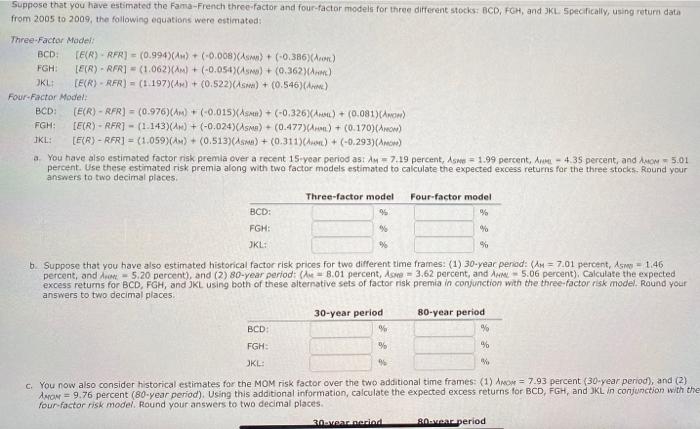Suppese that you have estimated the Fama-Frenth three-factor and four-factor models for three different stocks: BCD, FGH, and 3KL. 5 peeclically, using returi data from 2005 to 2009 , the following equations were estimated: Three-Factor Madeli BCD: [E(R)RFR]=(0.994)(A1)+(0.008)(sin)+(0.386)(tonc) FGH:[E(R)RFR]=(1.062)(M)+(0.054)(A5me)+(0.362)(AAHAC) JKL: [E(R)RFR]=(1.197)(AR)+(0.522)( sint )+(0.546)(ome) Four-Factor Model? BCD: [E(R)RFR]=(0.976)(AM)+(0.015)(AsMin)+(0.326)(nsM)+(0.081)(AM(0+1) FGH: [E(R)RFR]=(1.143)(K)+(0.024)(5M)+(0.477)(Arim)+(0.170)(roow) IKL.: [F(R)RFR]=(1.059)(A4)+(0.513)(sme)+(0.311)(AHet)+(0.293)(Amost) a. You have also estimated factor risk premla over a recent 15 yoar period as: y=7.19 percent, Aswe=1.99 percent, Arith 4.35 percent, and Amoy=5.01 percent. Use these estimated risk premia along with two factor models estimated to calculate the expected excess returns for the three stocks. Round your answers to two decimal places. b. Suppose that you have also estimated historical factor risk prices for two different time frames: (1) 30 -year penod: (AM = 7.01 percent, Asma = 1.46 percent, and Awin =5.20 percent), and ( 2 ) 80 -year period: (Au = 8.01 percent, done =3.62 percent, and Aime =5.06 percent), Calculate the expected excess retums for BCD,FGH, and JKL using both of these alternative sets of factor risk premia in conjunction with the three-factor risk model. Round your answers to two decimal places. c. You now also consider historical estimates for the MOM risk factor over the two additional time frames: (1) Amon = 7.93 percent (30-year period), and (2) Anow =9.76 percent ( 80 -year period), Using this additional information, calculate the expected excess returns for BCD, FGH, and JKL in conjunction with the four-factor risk model. Round your answers to two decimal places. c. You now also consider historical estimates for the MOM risk factor over the two additional time frames: (1) Awom =7.93 percent {30-year periad), and (2) imove =9,76 percent ( 80 -year period). Using this additional information, calculate the expected excess retums for BCD, FGH, and JKL in conjunction with the four-foctor risk model. Round your answers to two decimal places. d. Do all of the expected excess returns you calcutated in part (a) and part (b) make sense? If not, identify which ones seem inconsistent with asset pricing theory and discuss why. The excessi returns for for all periods seem moderately large. This is partly due to the fact that the regresslons unlike foctor risk premia were estimated using data from much periods








